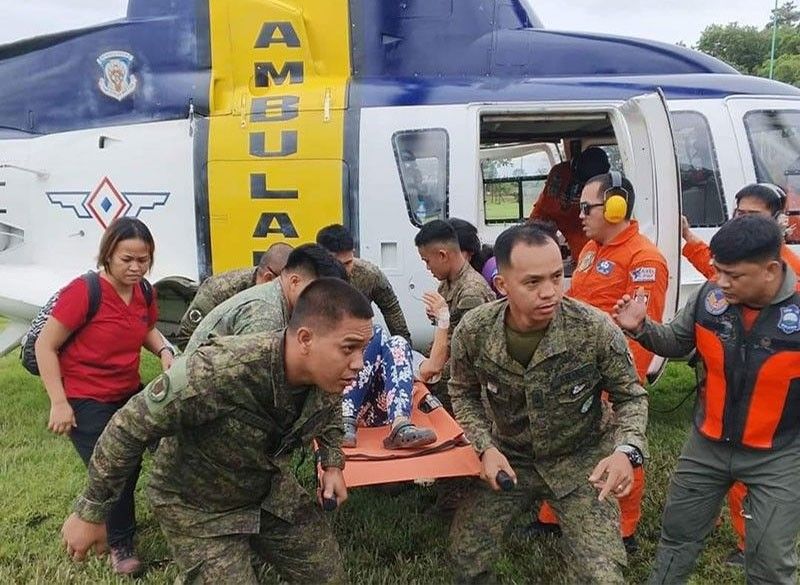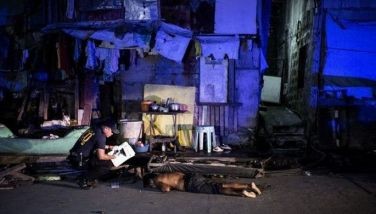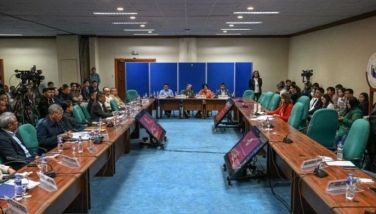Landslide deaths hit 28

MANILA, Philippines — The death toll in the landslide that devastated a mining community in Maco municipality in Davao de Oro has reached 28, disaster officials said yesterday.
Hopes for finding more survivors brightened with the rescue on Thursday of a young girl and a baby boy days after they were buried in mud and debris.
The Maco Municipal Disaster Risk Reduction and Management Office said the casualty figure as of noon yesterday stood at 28.
The National Disaster Risk Reduction and Management Council (NDRRMC)’s count was a notch lower at 27 the previous day.
A magnitude 5.8 earthquake in Mindanao forced a brief suspension of search and rescue operations in the remote gold-mining village of Masara. There were no immediate reports of injuries or damage from the earthquake.
“We ordered them (rescuers) to go up to a safer area,” Apex Mining Co. official Ferdinand Doble told a news conference yesterday. Apex operates the mining site in Maco.
As of 11 p.m. Friday, the NDRRMC said 35 people were reported injured in the disaster and 89 reported missing. The quake epicenter was about 150 kilometers north of the landslide site.
The landslide buried homes, as well as three buses and a jeep ferrying employees of the mining company to their community.
The NDRRMC said the landslide affected a total of 1,135 families or 5,318 individuals from four barangays in Maco, Davao de Oro.
The same situational report showed a total of 62 houses destroyed.
The NDRRMC said the three-year-old girl rescued on Friday was in stable condition after receiving medical attention at a hospital. The provincial government called her rescue “a miracle.”
The provincial government extended the search and rescue operations by another 48 hours, with more personnel and volunteers getting involved in the task.
Data on the number of bodies retrieved from under tons of soil and rocks in Maco were based on compiled reports from Maco MDRRMC, the Bureau of Fire Protection, the Police Regional Office 11, the Eastern Mindanao Command of the Armed Forces of the Philippines and the Davao de Oro provincial government.
The Maco local government, in a statement yesterday, confirmed that 28 bodies have been recovered since the start of rescue operations immediately after mud and other debris rumbled down a hill, covering a large part of Barangay Masara at past 7 p.m. Monday. The landslide came after a continuous downpour.
Sara’s visit
In a statement, Vice President Sara Duterte said she visited two evacuation centers at the Nuevo Iloco Elementary School and the Nueva Visayas Gymnasium in the town of Mawab near Masara.
“We personally talked to them (evacuees) to check on their situation. Most of them are awaiting news on their missing loved ones as the rescue and retrieval operations continue,” Duterte said.
Duterte said she has also coordinated with local officials for the delivery of assistance to evacuees.
“I also suggested a stress debriefing for all the evacuees currently staying in the evacuation centers, because it was really heart-breaking to hear the stories of what they went through,” Duterte added.
She reiterated in her statement the importance of pro-active measures on disaster risk reduction and management, such as pre-emptive evacuation, especially in identified hazard-prone areas.
“I have always been stressing the importance of proper preparation and proactive measures such as pre-emptive evacuation especially in residential areas identified as hazard prone in order to avoid tragedy. The safety of the public must always be top priority,” Duterte said. “I pray that this kind of incident will not happen again,” she added.
Apex Mining said it has set up a welfare desk helpline at the Nuevo Iloco National High School to assist residents in getting information on their missing loved ones.
“The company is deeply saddened by this tragedy and we can only imagine the pain that the families of the missing and the dead are going through,” said Apex CEO and president Luis Sarmiento.
He said the company is currently focusing its manpower and resources on supporting the provincial government in its relief operations. Since the tragedy struck, company has been providing food packs, drinking water and medical services to the affected communities.
Talks have also been initiated with the Department of Social Welfare and Development (DSWD) for psychosocial counseling to those who need it.
Apex also said that one of its four shuttle buses arrived safely at its destination in Mawab, while “the three buses and the jeepney have been found at ground zero of the landslide.”
Assistance
Apex Mining also said it has been closely coordinating with Rep. Ruwel Peter Gonzaga, whose office serves as the command center of the government’s response team.
“In this difficult time, we see the Filipino spirit of malasakit shine through with other companies in the metals and mining sector offering to help,” Sarmiento said.
The firm is also assisting the Mines and Geosciences Bureau and the Environmental Management Bureau of the Department of Environment and Natural Resources in their information gathering by regularly submitting aerial video footage of the landslide area.
“We’re still hoping to save more people even after four days,” Davao de Oro provincial disaster chief Randy Loy told a news conference.
However “we can’t really guarantee their chances of survival” after 48 hours, he said, adding 474 rescuers were deployed at the landslide area.
Military rescuers were set to employ specialized equipment, their commander Brig. Gen. Ronnie Babac said.
These include thermal scanners that can detect signs of life beneath the rubble as well as specialized “snake cameras,” also known as borescopes designed to peek into confined spaces.
Hero dog
Meanwhile, disaster teams have credited a dog for the rescue of the three-year-old girl in Masara.
Appa, a working canine of the Philippine Coast Guard, had just arrived from Caraga in Davao Oriental after helping locate two missing persons also in a landslide, when his services were tapped for the search of the missing in Masara.
Appa, a nine-year old aspin-golden retriever, has been in service for eight years.
Local officials are hoping that more survivors would be found. “Let’s continue the search and rescue operations and maybe extend it for a short time. We don’t know, maybe we’ll find more survivors,” Davao de Oro Vice Gov. Tyrone Uy said.
“We are still hoping for more to be saved. However, we cannot determine their chances of survival because there are pockets where they can breathe,” Provincial Disaster and Risk Reduction Management officer Joseph Randy Loy, for his part, said.
The PDRRMO said 55 houses were buried in the landslide.
The Department of the Interior and Local Government said a majority of the retrieved bodies were those of employees of Apex Mining, although it could not give exact figures and names.
As Masara residents try to come to terms with the recent tragedy, some of them claimed they may have been forewarned of it by a sinister image of a woman on the side of the mountain that crumbled. They said nobody dared to settle near the mountain, which they believed was home to supernatural beings.
Ednar Dayanghirang, Office of Civil Defense regional director, said that according to some evacuees, they saw what looked like a face of a woman on the wooded portion of the mountain that slid down. The residents claimed they saw the image at dusk before the landslide occurred.
Dayanghirang also said residents had been told to leave the area, as it had been hit already by two less destructive landslides.
“Prior to the main landslide there were various landslides that happened, that is why we cleared the roads so that if there are emergencies, people can still pass,” Apex Mining Incident Commander Ferdinand Dobli said.
Despite the area being declared as a critical zone, people kept going back.
He said people had told him they would rather stay to keep their livelihood than leave their homes and face hunger.
“They are there not for shelter, but food is their driver. They would rather take the high risk of losing life and getting sick than lose their livelihood,” he said.
Most people living in Zone 1 in Masara were either working at the mines or were traders and workers making a living indirectly from the mining operation. – Elizabeth Marcelo
- Latest
- Trending


























